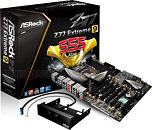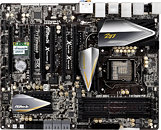Tuesday, May 15th 2012

ASRock Launches Z77 Extreme9 Motherboard
Seeing as how some of the newest socket LGA1155 processors, such as the Core i7-3770K, competes with Sandy Bridge-E HEDT platform, and how today's GPUs are beginning to benefit from PCI-Express 3.0 in x8 and x4 configurations, ASRock decided to go beyond its Z77 Fatal1ty Professional, and launched a new Extreme series model, with a focus on features and connectivity. The Z77 Extreme9 from ASRock crams has every square inch of its standard ATX size PCB with features.
To begin with, the Z77 Extreme9 uses a fairly strong 8+4 phase VRM, which is similar to that of the Z77 Extreme6. The CPU VRM MOSFETs are cooled by a fairly big heatsink, which shares its head with a neighbouring heatsink, which cools a PLX PEX8747 PCI-Express 3.0 bridge chip, which takes in the lone PCI-Express 3.0 x16 link from the processor, and drives four of the board's six PCI-Express 3.0 x16 long slots, enabling 3-way and 4-way SLI/CrossFireX capability. The other slots are electrical PCI-Express 2.0, and wired to the Z77 PCH.The Z77 Extreme9 packs a laundry list of features, starting with six SATA 6 Gb/s ports (two from the PCH, four from third-party ASMedia-made controllers), four SATA 3 Gb/s ports (from the PCH), and one eSATA (shares the port with one of the SATA 6 Gb/s ports driven by the ASMedia controllers). There are a total of 12 USB 3.0 ports, four of which are driven by the Z77 PCH, and eight by a pair of Etron EJ188 4-port USB 3.0 host controllers. The lone display output is an HDMI port, there are no DisplayPort connectors, so the availability of Thunderbolt is unlikely.
Other connectivity includes 8+2 channel HD audio, two gigabit Ethernet interfaces, 802.11 b/g/n (WiFi), Bluetooth 4.0, FireWire, USB 2.0 rear panel ports (useful for USB gaming peripherals without wasting USB 3.0), and a mouse/keyboard combo PS/2 port. The package includes a unique accessory called Wi-SB, which is a 3.5-inch front-panel enclosure, that relays two USB 3.0 ports from the headers to the front-panel, serves as a WiFi antenna, and has a 2.5-inch drive bay, for holding SSDs. To top it all off, are ASRock exclusives such as XFastRAM (memory optimization), XFastUSB (higher bandwidth), and XFastLAN (lower pings), and LucidLogix VirtuMVP.
The ASRock Z77 Extreme9 could be the company's most premium (read: expensive) Z77-based motherboard, prices could exceed US $450.
To begin with, the Z77 Extreme9 uses a fairly strong 8+4 phase VRM, which is similar to that of the Z77 Extreme6. The CPU VRM MOSFETs are cooled by a fairly big heatsink, which shares its head with a neighbouring heatsink, which cools a PLX PEX8747 PCI-Express 3.0 bridge chip, which takes in the lone PCI-Express 3.0 x16 link from the processor, and drives four of the board's six PCI-Express 3.0 x16 long slots, enabling 3-way and 4-way SLI/CrossFireX capability. The other slots are electrical PCI-Express 2.0, and wired to the Z77 PCH.The Z77 Extreme9 packs a laundry list of features, starting with six SATA 6 Gb/s ports (two from the PCH, four from third-party ASMedia-made controllers), four SATA 3 Gb/s ports (from the PCH), and one eSATA (shares the port with one of the SATA 6 Gb/s ports driven by the ASMedia controllers). There are a total of 12 USB 3.0 ports, four of which are driven by the Z77 PCH, and eight by a pair of Etron EJ188 4-port USB 3.0 host controllers. The lone display output is an HDMI port, there are no DisplayPort connectors, so the availability of Thunderbolt is unlikely.
Other connectivity includes 8+2 channel HD audio, two gigabit Ethernet interfaces, 802.11 b/g/n (WiFi), Bluetooth 4.0, FireWire, USB 2.0 rear panel ports (useful for USB gaming peripherals without wasting USB 3.0), and a mouse/keyboard combo PS/2 port. The package includes a unique accessory called Wi-SB, which is a 3.5-inch front-panel enclosure, that relays two USB 3.0 ports from the headers to the front-panel, serves as a WiFi antenna, and has a 2.5-inch drive bay, for holding SSDs. To top it all off, are ASRock exclusives such as XFastRAM (memory optimization), XFastUSB (higher bandwidth), and XFastLAN (lower pings), and LucidLogix VirtuMVP.
The ASRock Z77 Extreme9 could be the company's most premium (read: expensive) Z77-based motherboard, prices could exceed US $450.


13 Comments on ASRock Launches Z77 Extreme9 Motherboard
Your second paragraph should be amended to show this info.
The WS revo wires 8x to the first 16x slot and then provides 8x of the CPU's lanes to the pLX, that way ASUS can advertise more lanes than the others...., but provide only 8x to the PLX lol talk about increasing delay.
The Extreme9 takes all 16x lanes and provides them to the second slot, but if you run any multi-gpu configuration then all the lanes goto the PLX.
The G1.Sniper 3 sends all lanes to the PLX to begin with.
If you run a single card in any of the three boards above the G1.Sniper3 would be slowest, the WS second, and the extreme9 woudl be fastest.
If you run multi-gpu setup then G1.Sniper3 would be fastest, extreme9 would be second, and WS would be third. That is in theory however, the most switches you add the more complicated and more delays turn up.THere are some enthusiasts who would really disagree, basically the same ones that woudl disagree about using PLX with only 1 GPU if all the lanes went through it.
although I can't find two channel switches that would be required for that, perhaps they are on the back of the boardthey're under the battery). It does increase latency but can potentially provide the most bandwidth. I was referring to the Maximus 4 Extreme when I said they were following ASUS. The M4E has the first slot as x16 with 8 lanes through channel switches to either that slot or the PLX switch (if any other slot is occupied) and the other three slots are going to the PLX switch.I can't tell for certain whether the Extreme9 has the first or second slot natively linked to the CPU. Most likely the first slot. That's how ASUS and EVGA do it, logically ASRock would do the same in this case.
P8Z77 and G1.Sniper 3 would be the same for single GPU but bested by the Extreme9. With current GPUs the Extreme9 would likely have the lead until you were to do 3/4-way.
The ASRock Z77 extreme9 is just following the Z68 Extreme7. The design is cute but I don't know how much being switched twice really helps.
Here are the Z68 boards, the G1.Sniper 3 and P8Z77 WS Revo would follow the same as the UD7:
Note to cadaveca: this is precisely why I wanted you to take full board shots without heatsinks.
If that's right, and I'm fairly certain it is, I love this implementation.